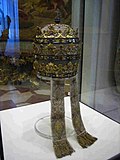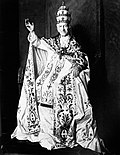| | Name | Year | Notes |
|---|
| 1 | | Tiara of Pope Gregory XIII | 1572–1585 | Decoration originally included an emerald (404.5 carats) later incorporated in the Napoleon Tiara. [2] |
| 2 |  | Papier-mâché Tiara | 1800 | Made for the coronation of Pope Pius VII in exile in Venice following the seizure or destruction of papal tiaras by the French troops that invaded Rome in 1798. Decorated with jewels donated by local families. Worn as a lightweight alternative for decades. [3] |
| 3 |  | Napoleon Tiara | 1804 | Napoleon I gifted a tiara to Pope Pius VII, who presided at his coronation as emperor in December 1804. Manufactured by Henri Auguste and Marie-Etienne Nitot of the House of Chaumet, its decoration celebrated that coronation and the Concordat of 1801. Some of its jewels and decoration came from tiaras taken by the troops of the French Directory in 1798. It was purposely made too small and too heavy to be worn. It was later modified and worn by Pius IX at his coronation in 1846 [4] and to open the First Vatican Council in 1868. It appears in Jacques-Louis David's 1807 painting The Coronation of Napoleon . [a] |
| 4 | | Tiara of Pope Gregory XVI | 1834 | One of the most worn in the papal collection. Worn at times by Pius IX, Pius X and Pius XII. [6] Decorated with three golden circles inlaid with diamonds over the central silver core of the crown, and above each circle a series of golden cloverleaves, inlaid with jewels. |
| 5 | | Tiara of Pope Gregory XVI | 1845 | |
| 6 | | Tiara of Pope Gregory XVI | date unknown | Lightweight version. |
| 7 | | Tiara of Pope Pius IX | 1846 | Created in 1854. With 18,000 diamonds and 1,000 emeralds, sapphires and rubies. Loaned by the Vatican Museum for display at the Metropolitan Museum of Art in New York, May-October 2018. [7] [8] |
| 8 |  | Spanish Tiara | 1855 | A gift from Queen Isabella II of Spain, weighing three pounds and topped with a single sapphire. [9] [10] Decoration included 18,000 diamonds, pearls, rubies, emeralds, and sapphires. |
| 9 | | Tiara of Pope Pius IX | late 1850s | A gift from the Congregation of Holy Cross. On permanent display in the Basilica of the Sacred Heart at the University of Notre Dame in Indiana. |
| 10 | | Belgian Tiara | 1871 | A gift to Pope Pius IX from the women of the Royal Court of the King of the Belgians made by Jean-Baptiste Bethune of Ghent. [11] [12] Decorated with three layers of upright golden decoration inlaid with jewels, including gold, pearls, gilt silver, emeralds, other precious stones, and enamel work. |
| 11 | | Tiara of Pope Pius IX | 1870s | Lightweight tiara. |
| 12 |  | Palatine Tiara | 1877 | A gift from the Palatine Guard to Pope Pius IX to celebrate the 50th anniversary of his consecration as a bishop. Relatively lightweight at two pounds, it was used at all later papal coronations until Pope Paul VI's in 1963. [13] [14] Decorated with six rows of 90 pearls as well as 16 rubies, three emeralds, a hyacinth, an aquamarine, three rubies, a sapphire, and eight gold points with five garnets and two Balas rubies (first tier); 10 emeralds, 8 Balas rubies, one chrysolite, two aquamarines, six small rubies and three sapphires (second tier); 16 small Balas rubies, three larger Balas rubies, four sapphires, three hyacinths, three aquamarines, one garnet, eight gold floral ornaments each with two emeralds, one Balas ruby, a chrysolite and eight gold points, each adorned with a garnet (third tier). The crown is covered with a thin layer of gold, with eight rubies and eight emeralds, surmounted by a gold globe enameled in blue and topped by a cross composed of 11 brilliants. [15] |
| 13 | | German Tiara | 1887 | A gift from Kaiser Wilhelm I of Germany in commemoration of Pope Leo XIII's Golden Jubilee as a priest. [16] Decorated with 1,000 pearls. |
| 14 |  | Paris Tiara | 1888 | A gift from the Catholics of Paris to celebrate the golden jubilee of Pope Leo XIII's ordination as a priest. By Émile Froment-Meurice. [17] He had quashed a proposal by Lyon Catholics to raise funds for a tiara in 1878. [18] |
| 15 | | Austrian Tiara | 1894 | A gift from Kaiser Franz Joseph I of Austria. [19] |
| 16 | | Golden Tiara | 1903 | Presented by Cardinal Pietro Respighi on behalf of the world's Catholics to commemorate the Pope Leo XIII's silver jubilee as pope. [20] [21] |
| 17 | | Tiara of Pope Pius X | 1908 | Created by papal jewelers Tatani to commemorate the golden jubilee of the ordination of Pope Pius X as a priest. Made because the pope found other tiaras too heavy. |
| 18 |  | Tiara of Pope Pius XI | 1922 | A gift from the Archdiocese of Milan. [22] Inlaid with 2,000 precious stones. |
| 19 |  | Tiara of Pope John XXIII | 1959 | A gift to Pope John XXIII from the people of Bergamo, his home region, in honour of his election. Worn on occasion. [23] |
| 20 |  | Tiara of Pope Paul VI | 1963 | The last tiara worn at a papal coronation. Made by laboratories of Scuola Beato Angelico of Milan in a modern style with minimal ornament. Half the weight of the Palatine tiara of Pius IX used at coronations from 1877 to 1958. Now on permanent display in the Basilica of the National Shrine of the Immaculate Conception. [24] |
| 21 |  | Tiara of Pope John Paul II | 1991 | Presented to Pope John Paul II by Catholics in Hungary. [25] Location unknown. Appears in a photograph of a medal said to be held in the Bayerisches Münzkontor. [26] According to the press of the time, the tiara presented by the Hungarian Catholic Bishops' Conference on the occasion of popes visit to Hungary in 1991. It was based on plans by industrial designers Tibor Jeney and Edit Oborzil. [26] Never worn. |
| 22 |  | Tiara of Pope Benedict XVI | 2011 | Presented to Benedict XVI on 25 May 2011 by a group of German Roman Catholics; created by Bulgarian Eastern Orthodox Christians. [27] Never worn. |
| 23 | | Tiara of Pope Francis | 2016 | Presented to Pope Francis on 16 May 2016 by the President of the Assembly of North Macedonia, Trajko Veljanovski. Made by the nuns of the monastery of Rajčica, with pearl from Lake Ohrid. [28] Never worn. |
|









